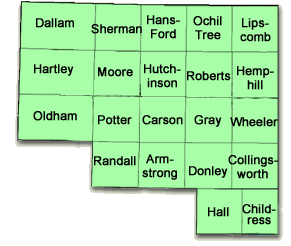Region A - Panhandle
2005 Regional Water Plan Overview

Regional Facts

Major Cities | Amarillo |
| Population: 2000 | 355,832 |
| Population: 2060 | 541,035 |
| Total Water Use: 2000 | 1,943,551 Acre-Feet |
| Total Water Use: 2060 | 1,435,357 Acre-Feet |
| Primary Rivers | Canadian, Red |
| Major Aquifers | Ogallala |
| Annual Precipitation | 16-24 Inches |
| Net Evaporation | 48-56 Inches |
Basic Plan Facts
- The population of Region A is projected to increase by more than 50 percent by 2060.
- Total capital cost of proposed water supply measures: Not available
- No new reservoirs proposed
What's at Issue?
In 1995, 97% of the total water used in this region was drawn from the Ogallala aquifer. This aquifer, however, is being depleted and the current regional plan is proposing to deplete this resource 50% over the next 50 years. Because the aquifer recharges very slowly, this means that only one half of the current supply will be left for future generations. The plan emphasizes conservation strategies for irrigators, but lacks a long-term mechanism for achieving a sustainable management strategy. Much more can be done to help support the water demands over the planning period, including the environmental water needs of the region.
Action Items
Here are some of the items the Region A Planning Group must address.
 Conservation and Drought Management
Conservation and Drought Management
For conservation and drought management, the plan needs to...
- Recommend advanced municipal water conservation efforts. The median usage in the region is 185 gallons per capita per day (gpcd) with a range from 333 gpcd to 75 gpcd. By contrast, the Water Conservation Implementation Task Force recommends a goal of 140 gpcd.
- Include stronger industrial conservation measures.
- Include drought management as a water management strategy. Each water user group with a shortage should use a drought management strategy derived from its drought management plan as a way to meet their water needs. The regional plans in the state are based on a drought of record and it only makes sense that drought management should play a large role in planning to meet the region's water needs during that drought period.
 Environmental Flows
Environmental Flows
To secure the protection of flows for fish and wildlife, the plan needs to...
To secure the protection of flows for fish and wildlife, the plan needs to...
- Recognize environmental flows as a water demand and seek to provide reasonable levels of environmental flows.
- Assess the effects of planned future depletions and projects on environmental flows. This is especially important as the planning group contemplates a 50 percent decline in the volume of the Ogallala Aquifer over the planning period. When full, aquifers provide spring flows and dry weather flows for rivers and streams.
- Designate stream segments in the region that meet the criteria as having "unique ecological value". The Texas Parks and Wildlife Department recommends 14 segments for designation in this region.
- Provide detailed information about the springs in the region. This level of detail is necessary for evaluating the potential impact of proposed water management strategies.



 Region A
Region A